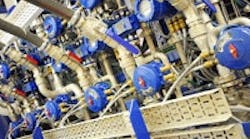"Like so many beached whales on the pier at Santa Monica," I told my boss with a wink. Paul winced, then smiled. "Expensive whales," he replied curtly. Someone had ordered a dozen or so direct-mounted Coriolis meters without checking their temperature limits. Flow meter selection and specification is crucial. With the wrong choice you'll be floundering or worse. So, let me make some suggestions.
[pullquote]
Flow meters infer flow by measuring how a property changes over time. They do so using a variety of techniques: differential pressure (dP) — orifice, venturi, V-cone, flow nozzles, wedge and pitot tube; velocity — magnetic, vortex shedding and ultrasonic; displacement — lobe or vane, piston, turbine, target and variable area (rotameter); and open channel — weir and flume. Coriolis and thermal meters infer mass flow from the force change caused by accelerating a mass away from a center of gravity. There also are special meters — e.g., nuclear and weight/time.
If you need an FDA-approved meter, your choice is limited. FDA-approved meters must meet two conflicting objectives: cleanability — e.g., polished surfaces, no dead spaces, large surfaces; and, extreme accuracy. Coriolis flow meters fit these criteria, challenging all comers with the possible exception of magnetic meters.
[javascriptSnippet ]
In all other cases, select your meter based on operating conditions. Let's subdivide these into clean, corrosive or erosive, and mixed phases.
For clean, single-phase fluids, the choice depends upon needed accuracy and acceptable price. Where there's space in the pipe, cost isn't an issue, and diameter is less than 6 in., the vortex shedding meter is the best choice. Beyond 6 in. diameter, accuracy and turndown suffer but nothing really beats the orifice plate. You can improve the accuracy of orifice plates and other dP meters and vortex-shedding meters by using multivariable technology to correct for property variation. If you're dealing with an under-6-in.-dia. pipe and accuracy isn't critical, rotameters and displacement meters can fit the bill nicely without the space requirements of the vortex shedders.
Dirty fluids pose more of a challenge. Muck can clog unpurged dP impulse lines and pitot tubes, grit can cut or foul vortex shedding bars and gnaw at wedges, orifices, rotameter floats, weirs, flumes and even Coriolis vibrating tubes. However, it's possible to use many of these flow meters if there are allowances for maintenance or purging. In one application, we heated N2 to purge a ceramic wedgemeter that we replaced annually. Vortex shedding meters are completely unacceptable in erosive or fouling service; on two occasions, in two different industries, I have seen catastrophic failures of such meters.
If erosion is the issue, consider hard ceramic dP elements, such as flow tubes and venturis, for pipes up to 6-in. dia. (fabrication isn't practical above 6-in. because of the size of ceramic sintering presses needed). Ceramics in order of performance are: silicon nitride (Si3N4), silicon carbide (SiC), zirconium carbide (ZrC) and, finally, aluminum oxide (Al2O3), the least expensive choice. An alternative is a vapor-deposition coating on a metal, but this is less effective against erosion. Such a coating may work with hard alloys based on nickel, zirconium or tantalum but avoid soft alloys containing a lot of titanium or copper.
Corrosive fluids, such as wet (above 12 ppm-m) chlorine or high-sulfur gas oil, raise an additional challenge beyond the debris created by corrosion. Impulse lines require special attention; small pipes and tubing risk fouling as witnessed in several recent pipeline thermal-relief failures. If you have to guess, go with nickel-chromium-tungsten alloys for chlorine and iron-nickel-molybdenum-chromium alloys for sulfur; the former is an inferior, second choice with sulfur. Alloy steels tend to suffer local attacks; their surface doesn't wear away like carbon steel, making erosion mil rates superfluous. Whenever possible, use corrosion coupons to decide on the material. Corrosion particulates like ferric sulfite, common with high-sulfur crude intermediates, are as hard as ceramics, so consider ceramics as replacements for metals. Erosion and fouling largely rule out velocity, mass and displacement meters for closed flow but not special meters.
Weight-time systems typically are reserved for solids and slurries but have been used for liquid measurement. Methods involving non-intrusive techniques such as ultrasonic have been employed with some success. Another technology, used for emulsion interface detection, may be on the horizon: nuclear magnetic resonance. Down-hole welling logging has applied this technology for decades to determine sand permeability.
Lastly, let's consider options for multi-phase flow. As of 2011, there are 3,000 multiphase "flow meters" being used in crude oil production. These are simply process controller accountings of separate phase flow measurements using sophisticated phase models often employed in process simulations. An unexpected benefit of this approach is the testing of these phase models in the real world.
Once you've installed a meter, check on its performance using field measurements. Theses can include how long it takes to empty a tank to measuring the dP through pipe and equipment and comparing this to known flow rates.



